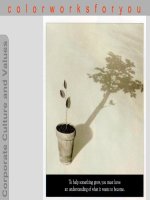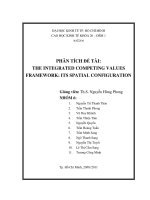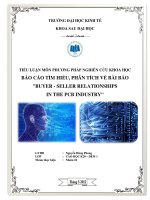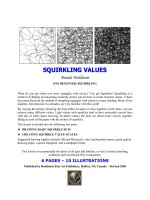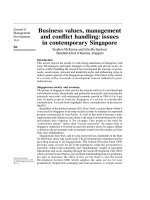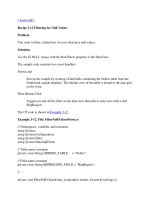Squirkling Values
Bạn đang xem bản rút gọn của tài liệu. Xem và tải ngay bản đầy đủ của tài liệu tại đây (1.08 MB, 6 trang )
S
S
S
Q
Q
Q
U
U
U
I
I
I
R
R
R
K
K
K
L
L
L
I
I
I
N
N
N
G
G
G
V
V
V
A
A
A
L
L
L
U
U
U
E
E
E
S
S
S
Brenda Hoddinott
D-01 BEGINNER: SQUIRKLING
What do you get when you cross squiggles with circles? You get Squirkles! Squirkling is a
method of shading incorporating randomly drawn curved lines to create textured values. I chose
this name based on the method of morphing squiggles with circles to create shading. Many of my
students, from the past two decades, are very familiar with this word!
By varying the density (drawing the lines either far apart or close together) of the lines, you can
achieve many different values. Light values with squirkles tend to have noticeable curved lines
with lots of white space showing. In darker values, the lines are drawn more closely together,
filling in most of the paper with the texture of squirkles.
This lesson is divided into the following two parts:
DRAWING BASIC SQUIRKLE SETS
CREATING SQUIRKLE VALUE SCALES
Suggested drawing supplies include HB and 4B pencils, vinyl and kneaded erasers, good quality
drawing paper, a pencil sharpener, and a sandpaper block.
This lesson is recommended for artists of all ages and abilities, as well as home schooling,
academic and recreational fine art educators.
6 PAGES – 10 ILLUSTRATIONS
Published by Hoddinott Fine Art Publishers, Halifax, NS, Canada – Revised 2005
Copyright to all articles, images, text, projects, lessons and exercises within this drawing class belong to Brenda Hoddinott and may
not be reproduced or used for any commercial purposes whatsoever without the written permission of Brenda Hoddinott.
Web sites and
2
DRAWING BASIC SQUIRKLE SETS
Squirkling is a method of shading incorporating randomly drawn curved lines to create textured
values and graduated value scales. In this section, you use a 2B pencil to draw three squirkle
values. Values are the different shades of gray created by varying the density of the shading
lines, and/or the pressure used in holding various pencils.
In this exercise, the values are rendered by drawing curved and compound curved lines either far
apart or close together. Curved lines are created when a straight line curves (or bends). Examples
of curved lines include the letters C and U. A curved line can become a circular shape when the
ends meet as in the letter O. A compound curve is created when a straight line curves (or bends)
in more than one direction. An example of a compound curve is the letter “S”.
Squint your eyes and look at the following sets of squirkles.
ILLUSTRATION 01-01
The first set (on the far
left) has very few lines
drawn far apart,
creating the illusion of a
light value. The second
set is darker, and the
third set is the darkest.
ILLUSTRATION 01-02
1. Draw a set of lines
that curve in many
different directions.
Notice that some
individual lines cut
across themselves in
many places, creating
lots of different
shapes, an abstract
composition, and an
overall light value.
The old expression
“few and far
between” works well
here. The lines are far
apart and few in
number.
Copyright to all articles, images, text, projects, lessons and exercises within this drawing class belong to Brenda Hoddinott and may
not be reproduced or used for any commercial purposes whatsoever without the written permission of Brenda Hoddinott.
Web sites and
3
ILLUSTRATION 01-03
2. Draw a second set of
squirkle lines that are
closer together than in
your first set.
Note that there are more
lines than in the first set
and the lines are closer
together.
ILLUSTRATION 01-04
3. Draw the darkest set
of squirkle lines very
closely together.
Many more lines
make up this third
squirkle set, and the
lines are much closer
together.
Very little of the
white paper is still
showing.
Copyright to all articles, images, text, projects, lessons and exercises within this drawing class belong to Brenda Hoddinott and may
not be reproduced or used for any commercial purposes whatsoever without the written permission of Brenda Hoddinott.
Web sites and
4
CREATING SQUIRKLE VALUE SCALES
In this exercise you vary the density of the lines (as in the previous exercise), and also use
various pencils to help render five different values with squirkles. Before you begin, practice
drawing squirkles with each of the three pencils and notice their differences. The 2H is the
lightest (hardest) and the 4B is the darkest (softest). The 4B is very good for darker values, 2B is
great for middle values, and 2H works well for light values.
ILLUSTRATION 01-05
1. Using your 2H pencil,
draw the first two values
beginning with the
lightest.
More lines are used to
create the second value
than the first.
ILLUSTRATION 01-06
2. With your 2B pencil,
draw the next two
values.
Again, pay attention to
the density of the lines so
each progressive value is
darker than the last.
ILLUSTRATION 01-07
3. Use your 4B to draw the darkest value.
Keep practicing these values in your sketchbook until you
can draw all five different values.
Copyright to all articles, images, text, projects, lessons and exercises within this drawing class belong to Brenda Hoddinott and may
not be reproduced or used for any commercial purposes whatsoever without the written permission of Brenda Hoddinott.
Web sites and
5
4. Draw another value scale from light to dark, and then try one from dark to light.
Refer to these completed value scales to see the five values in sequence.
ILLUSTRATION 01-08
ILLUSTRATION 01-09
ILLUSTRATION 01-10
The beauty of squirkles
is its ability to produce
an infinite range of
values and a variety of
textures.
Texture is the surface
detail of an object, as
defined in a drawing
with various shading
techniques. The senses
of touch and sight help
identify the surface
texture of drawing
subject.
Examine the wool on
this cartoon sheep and
identify a light, medium
and dark value. Note
how the different values
make the sheep’s body
look three-dimensional.

